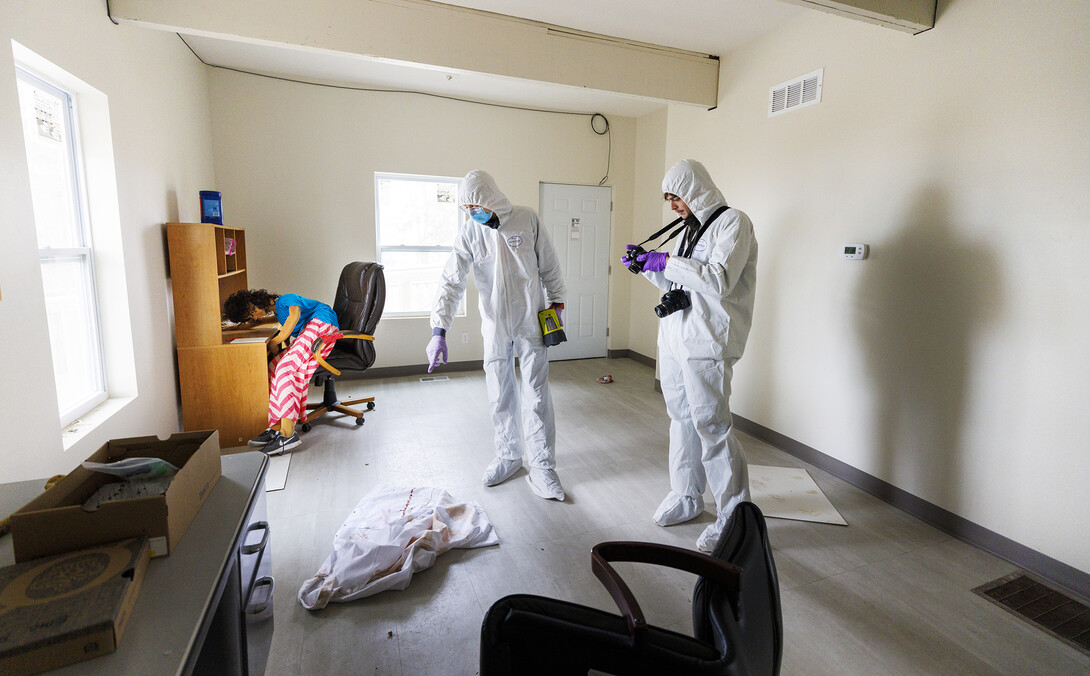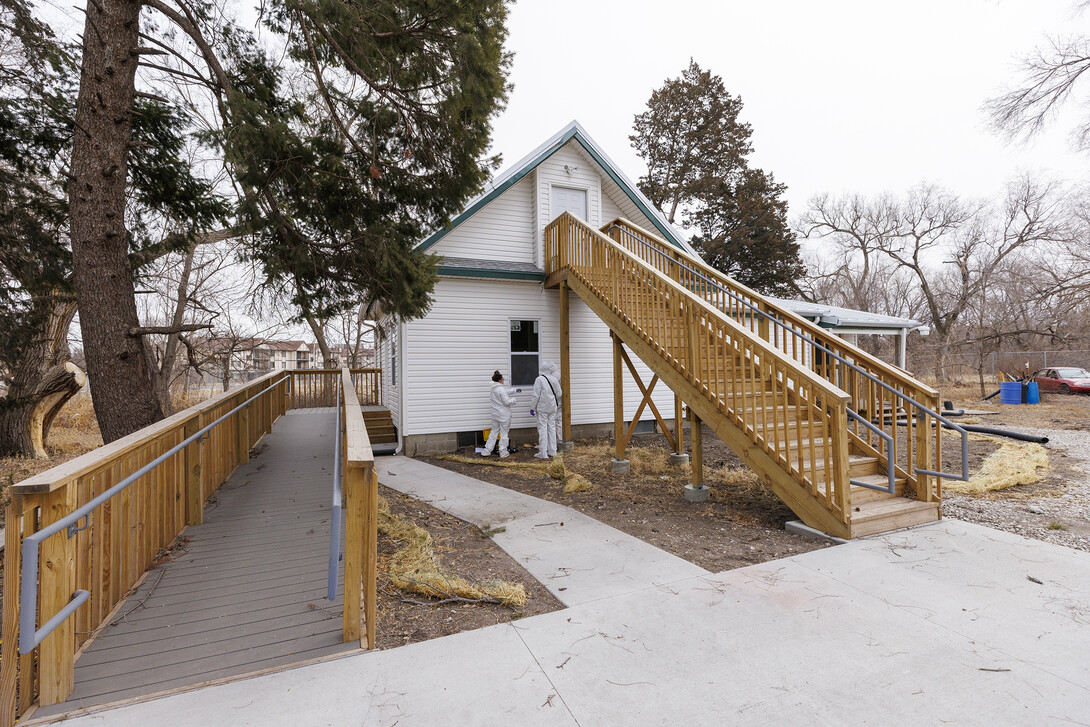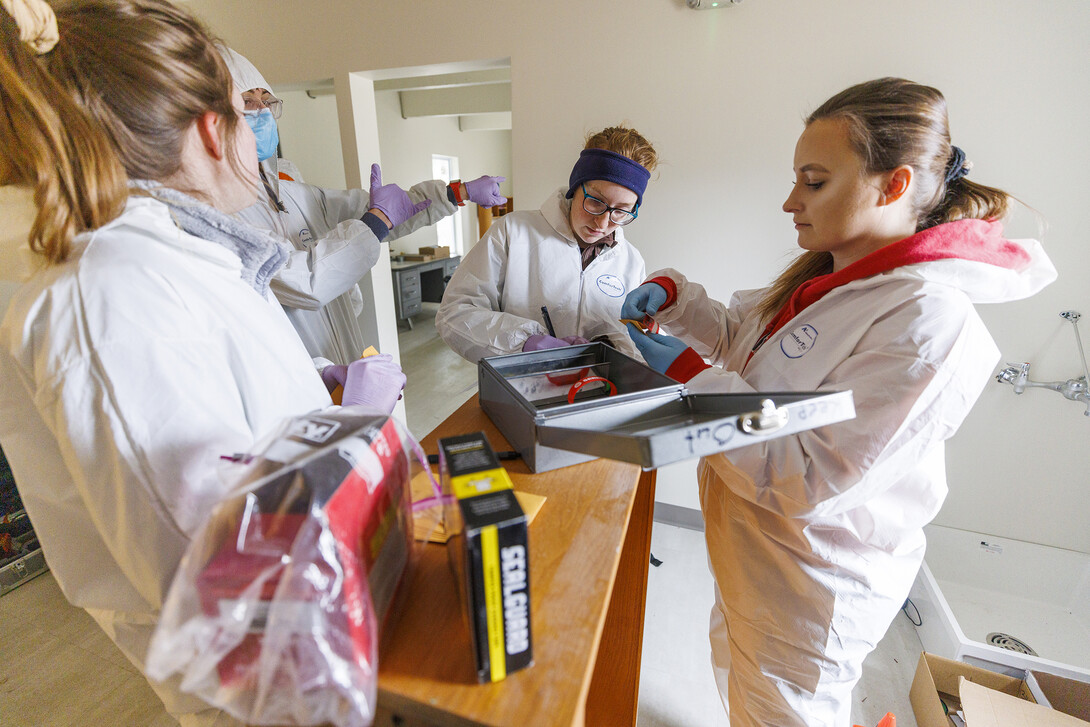
After spending years processing mock murders in the cramped confines of a small storage room inside Filley Hall, forensic science students at the University of Nebraska–Lincoln are now getting to stretch their crime scene investigation skills at the Crime Scene House on East Campus.
It’s a game-changer for the students, said Michael Adamowicz, director of the forensic science program, and Larry Barksdale, assistant professor of practice with the program. Previously, students had to work in teams of two in the small room processing the mock crime scene for the forensic science capstone course held each spring. With the interior of a house now available, the whole crew can work together, creating an atmosphere much more akin to real life.
“It’s an immersive experience and very similar to what they’ll be doing in the future,” Adamowicz said. “The students can all get in at once and work as a team. It makes everything run more efficiently and it’s saved us time.”
Barksdale said he was able to make the scene more complex with more room, draw in the whole property for processing and make accommodations for the sometimes unpredictable Nebraska weather.
“There’s a lot more places to look,” said Barksdale, a retired Lincoln Police detective. “We’ve been able to include the car in the case. We’ve put fingerprints on the windows outside to process. They’ll be doing 3D scanning of the entire house. Another benefit, I think, of the house is that we can now work with the weather. We can do outside techniques, go back in and get warm, and go back out.
“In addition, it was not feasible to put tire tracks or shoes prints in the snow and expect them to not be disturbed, and it was not cool to put fingerprints on outside windows in Filley Hall. We can now do that with the crime scene house and students can learn to process for evidence in the cold. Doing things in the cold takes special techniques and a strong spirit but is a good experience to have for this kind of work.”

Students on the crime scene investigation track within the forensic science program have developed a lot of their skills in labs held outside at the property, which includes an old car riddled with bullet holes, varied tire treads for comparisons, faux shallow graves and more. But the interior of the house had been unusable until now. The house and surrounding property underwent extensive renovations and cleanup. Weather, six-legged creatures and a hole in the roof had all caused significant damage to the house, which became part of the program in 2016.
“It was in far worse condition than we originally thought. We had to take it down to the studs, and in some cases, even replace studs because of termite damage, but everything turned out great,” Adamowicz said. “We also had to add the ramp outside and a staircase to the upper level to make it compliant with all laws.
“After so many delays, we’re really happy it’s done. It was a long process, for a variety of reasons, but we were very fortunate that our administration kept it moving, especially Ron Yoder, who was a champion for the project.”
Completion of the house came just in time, as the number of crime scene investigation students taking the capstone course will nearly double next year. The forensic science program has seen marked growth in the last four years.
“I really don’t know how we could have handled that many students processing a Filley Hall crime scene, only having two in a room at a time,” Adamowicz said.

Kara Peightal, a senior forensic science major from Omaha, said the house adds variety to what the students have been able to do.
“Last year, we were kind of stuck doing all of our stuff on the car, and it was kind of like processing the same scene every week,” Peightal said. “Now we can be inside and process a much larger scene, and have space to do it.”
For the capstone course, Peightal chose to oversee the photography of the scene. Working indoors and outdoors, with different surfaces and evidence, built on the skills she’d learned previously.
“I had to be aware of the different filters I’d need, and we’ll also be doing 3D imaging and scanning of the entire house,” she said. “That’s really cool to do because we’re using a Faro scanner, which is a really expensive piece of equipment, and I’m learning how to use it. Most CSI programs don’t have stuff like that.”
The house needs additional furniture, which will be acquired in the summer. In the fall, the house will be incorporated into FORS 120: Introduction to Forensic Science and FORS 400: Crime Scene Investigation. Adamowicz and Barksdale said the house is going to add more opportunities for students to learn, and they’re both excited to explore the possibilities.
“Whenever an asset gives you more options for your students, that’s a good thing,” Adamowicz said. “Really, our only limitations are the bounds of our imaginations.”








